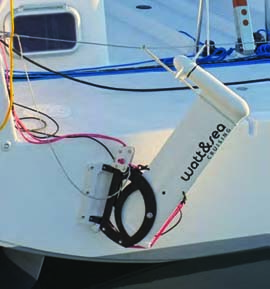by HILARY WIECH, COMMUNICATIONS MANAGER, AND ANNIE BRETT, PROGRAM DIRECTOR, SAILORS FOR THE SEA
It may seem silly to talk about renewable energy in the sailing world – aren’t sailboats powered by the wind after all? But look a little more closely, and for each sailboat on the water, there are several energy consuming engines, generators and batteries making sure we can get from point A to B. With climate change an increasingly pressing concern for the oceans and the environment, reducing our use of fossil fuels is critical.
That being said, some of the best arguments for alternative energy sources are purely practical. The cruising community, for instance, has long embraced renewable energy as a way to reduce costs and help make long passages possible on small amounts of diesel fuel. Solar panels and wind generators are almost ubiquitous on liveaboards, allowing cruisers to maintain battery banks while far away from traditional energy sources. Here at Sailors for the Sea, we have noticed a big increase in the use of renewable energy with racing sailors as well. More efficient and cost-effective technologies mean that many of the same benefits the cruising community has long understood are now workable for racers. Whether switching a race committee boat to biodiesel or sailing around the world without a drop of diesel, race organizers are looking towards alternative energy sources. The America’s Cup, The Atlantic Cup, and the Vendée Globe are each taking a different approach to reducing their environmental footprint with the use of alternative energy.
Race organizers at the America’s Cup have taken a strong stance on sustainability with a commitment to running every event in accordance to our Clean Regattas certification criteria and helping us create a stringent Platinum Level certification. The on-shore footprint of the America’s Cup is very large, with multiple venues scattered throughout San Francisco and an anticipated hundreds of thousands of visitors during the three months of racing. Organizers have committed to holding a carbon neutral event, and to achieve this they will utilize renewable energy in different ways:
Past America’s Cup World Series events have seen organizers turn to solar power for some of their energy needs. Security lights powered by solar panels will reduce electrical use for lights that need to be very bright and on 12 hours a day. Solar panels will cover the top of the sound stage and generate enough power to boom the announcers’ voices over the large crowds.
When the America’s Cup is unable to use shore power and generators are necessary, using biodiesel will help reduce their fossil fuel usage and emissions.
The Atlantic Cup presented by 11th Hour Racing, run for the third time in May, has always received Gold level Clean Regattas certification. Organizers require that every team use a form of alternative energy and, through their sponsors, assist teams with making the switch. Many boats in the Class40 circuit use hydro-generators to charge their batteries. Much like an upside-down wind generator, they have become popular in recent years as their increasing efficiency and reduced drag means they barely affect a boat’s speed.Many boats are equipped with solar panels to charge their batteries, and when engines must be run (hopefully only to and from dock) race organizers supply biodiesel for each boat.
The Vendée Globe is a grueling solo ‘round the world race from west to east via the three major capes: Hope, Leeuwin and the Horn. In years past, about half the fleet did not finish. For many years, racers have relied on some form of renewable energy to make it all the way around the world, typically a combination of solar panels and diesel to keep their batteries charged. However, this year one sailor set out with the goal of completing the race without using a single drop of diesel. Javier Sanso on Team ACCIONA created a 100% eco-powered boat, using a combination of solar panels, wind generators, and hydro-generators to charge batteries.
An electrical engine, a first in the history of the race, was used in place of a standard diesel engine. Team ACCIONA has to ask for the race rules to be changed to allow for the electrical engine, opening possibilities for the future. If Sanso had completed the race, he would have been the first to do so without using fossil fuels. Unfortunately his keel broke and the boat flipped with approximately ¼ of the race left.
Take Action!
- Donate to Sailors for the Sea and our Clean Regattas program, which encourages and supports race organizers to use alternative energy.
- Sail in a Clean Regatta, or make your sailing event a Clean Regatta. Events that use our certification program produce less waste, are less likely to have oil spills, and encourage participants to protect the waters they sail upon.
- Use alternative energy on your boat. Biodiesel is more readily available, and solar panels and wind generators are becoming more efficient.
- Consider an electric engine. Check out the Torqeedo, a great replacement for a standard outboard engine.




